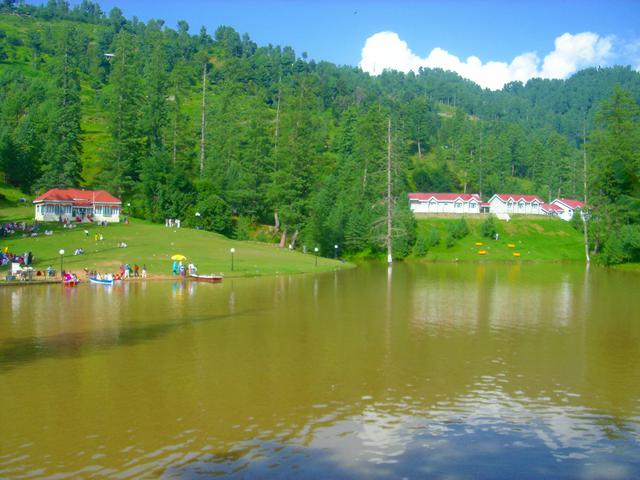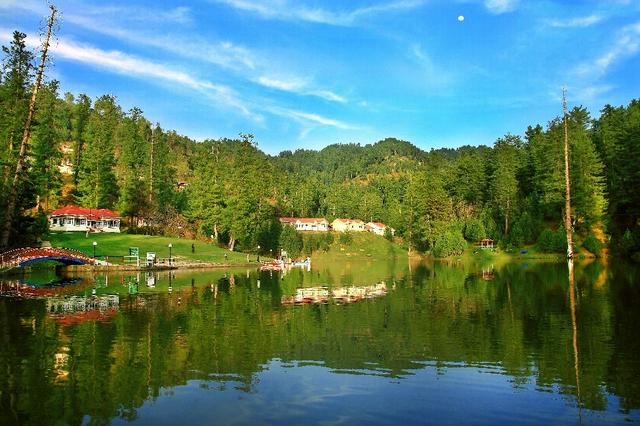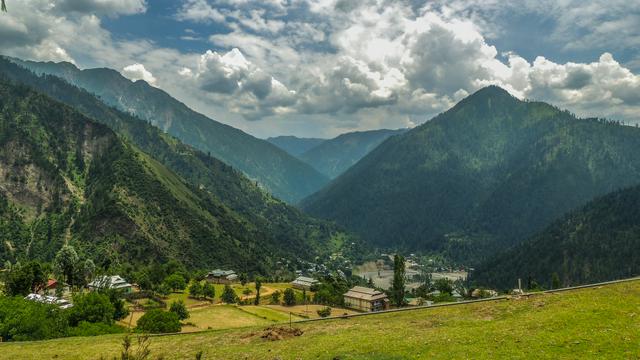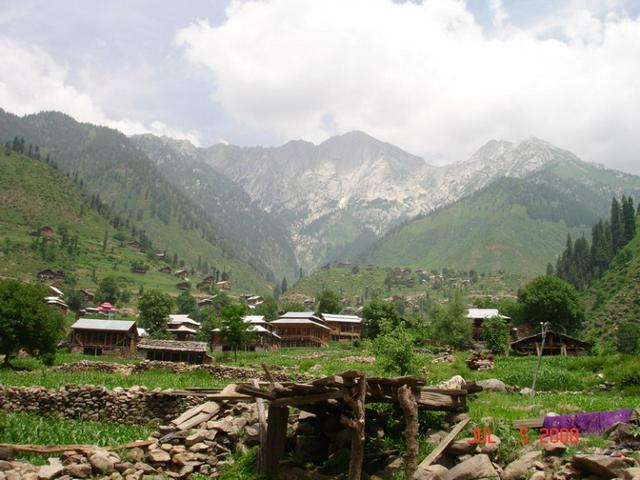
For the Indian-controlled part of Kashmir, see Jammu and Kashmir.
Azad Jammu and Kashmir (Urdu:آزاد جموں و کشمیر) or, for short, Azad Kashmir (literally Free Kashmir), is the Pakistani-controlled portion of Kashmir, lying west of Indian-controlled Jammu and Kashmir.
Nice people and fertile, green and scenic mountain valleys are characteristics of Azad Kashmir, making it one of the most beautiful regions on the Subcontinent. While Kashmir as a whole is undoubtedly one of the most beautiful regions in the world, Azad Kashmir is as well rich in natural beauty and often dubbed "Heaven on Earth" by tourists for its scenic natural beauty and stunning landscapes. Its snow-covered peaks, forests, rivers, streams, valleys, velvet green plateaus and climate varying from arctic to tropical combine to make it an excellent and popular tourist destination both for domestic and foreign tourists throughout the year.
Azad Jammu and Kashmir, Pakistan is a remote quite a semi-small Autonomous state, with 3 administrative divisions:
1. Mirpur Division
2. Muzaffarabad Division
3. Poonch Division
- Muzaffarabad. – the capital of the state and close to the epicenter of the 2005 earthquake
- Bagh.
- Bhimber.
- Chak Haryam. hills on both sides of the river, lush green forests, enchanting streams, high altitude lakes and attractive surroundings
- Kotli.
- Mirpur. – the second largest city of Azad Kashmir and popular for its nearby Mangla view resort
- Rawalakot. – a place of great natural beauty
Muzaffarabad. – the capital of the state and close to the epicenter of the 2005 earthquake
Bagh.
Bhimber.
Chak Haryam. hills on both sides of the river, lush green forests, enchanting streams, high altitude lakes and attractive surroundings
Kotli.
Mirpur. – the second largest city of Azad Kashmir and popular for its nearby Mangla view resort
Rawalakot. – a place of great natural beauty
- Banjosa lake.
Banjosa lake.
 Azad Kashmir has a population of four million. It is a self-governing territory controlled by Pakistan. It borders the Indian-controlled state of Jammu and Kashmir to the east (separated from it by the military control line between the Indian and Pakistani-controlled parts of the former princely state of Jammu and Kashmir "Line of Control").
Azad Kashmir has a population of four million. It is a self-governing territory controlled by Pakistan. It borders the Indian-controlled state of Jammu and Kashmir to the east (separated from it by the military control line between the Indian and Pakistani-controlled parts of the former princely state of Jammu and Kashmir "Line of Control").
A devastating earthquake hit Azad Kashmir in 2005 centered near the city of Muzaffarabad. It was the eighteenth deadliest earthquake of all time and aid teams from around the world came to the affected region to assist in relief.
The culture of Azad Kashmir has many similarities to that of northern Punjabi (Potohar) culture in Punjab province.
The climate of Azad Kashmir varies with altitude. The central and northern parts, as a mountainous area in the lesser Himalayas zone, is very cold in winter with snowfall and moderate in summer, while the southern parts of Azad Kashmir have extremely hot weather in the summer and only moderately cold weather in the winter. Azad Kashmir receives rainfall in both winters and summers.

The northern part of Azad Kashmir encompasses the lower part of the Himalayas where scenic views are in abundance which make it a very popular holiday-retreat during the summer months.
There're many tourist spots but some most well-known are the two historical forts Red Fort (Chak Fort) and Black Fort located on the bank side of the Neelum River in Muzaffarabad. They were contracted in 16th century and holds archaeological significance. Pir Chinasi is tourist spot 30 km east of Muzaffarabad on the top of hills at the altitude of 9,500 feet (2,900 m). The mountain peak has gained large fame for its ziyarat of a famous Saint Pir and this place is visited by tourists who can get a great view of Muzaffarabad and rural areas around the hidden city.
Neelam Valley is a long river, possesses scenic beauty, great panoramic views, towering hills on both sides of the noisy river, lush green forests, enchanting streams and attractive surroundings. Another great river is the Leepa Valley which is full scenic beauty as well. It has high mountains covered with pine trees covered with snow during the winter season.
Some other great tourist attractions are extremely beautiful artificial Banjosa Lake surrounded by densely pine forest and mountains, which make its very charming and romantic. A nearby hilltop Toli Pir is very natural beautiful area.
 Azad Kashmir is known for its great valleys and high lush green mountain ranges which means adventurer outdoor recreation opportunities are plentiful. It has varied mountainous landscape ranging from low hills to high mountains (2000 to 6000 m) which are suitable for many adventure sports such as climbing, trekking, mountaineering, summer camping and hiking or even paragliding.
Azad Kashmir is known for its great valleys and high lush green mountain ranges which means adventurer outdoor recreation opportunities are plentiful. It has varied mountainous landscape ranging from low hills to high mountains (2000 to 6000 m) which are suitable for many adventure sports such as climbing, trekking, mountaineering, summer camping and hiking or even paragliding.
Azad Kashmir is a great place for water sports activities, from rafting, canoeing and kayaking to wind surfacing, boating, rowing and hovercraft.
Pashmina
The popular and traditional cuisines of Azad Kashmir are Kashmiri Raan (Fried leg of lamb in Kashmiri style), Rogan Josh, Balti Gosht, Kashmiri Dal Chawal (A mixture of split peas, split red lentils, and boiled rice), and Dam Aloo (Fried Potatoes in Kashmiri style).
Kashmiri tea (Kashmiri chai) is a traditional tea beverage of Azad Kashmir. It is slow-steeped milk tea of a creamy pink complexion made from special tea leaves, milk, salt, pistachios, almonds, and cardamom and sometimes cinnamon is also added for flavour.
Azad Kashmir is quite safe region as compared to rest of the country where every province has become the target of some terrorism activities.
Crime-wise Azad Kashmir is considered to be relatively safe, but there are some criminals who prey on tourists during high season, so it is always best to keep a low profile.
Sometimes, temperatures go below freezing, especially in the winter; dress accordingly.
Some parts of Azad Kashmir are off-limits to tourists, particularly the 15-mile-wide buffer zone or 16 km along the Line of Control that separates the state from the neighbouring Indian state of Jammu and Kashmir. Domestic tourists can visit Azad Kashmir without any restriction, but are advised to keep their identity papers with them. Foreign tourists are allowed to visit the following places only with a permit: Dheerkot, Rawalakot, Chotta Gala, Chikkar, Daokhan, Muzaffarabad, Mangia and Sehnsa. Permits are issued by the AJK Home Department at Muzaffarabad.
Don't take photographs of military installations or you'll be in very serious trouble.
